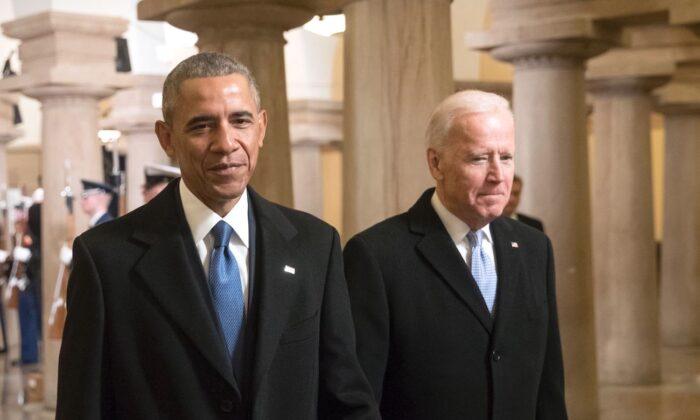The opportunistic timing of this ascendant strand of argumentation is as obvious as its logic is facile. The basic argument is: Trump the individual is largely inextricable from the substantive political commitments of the “New Right”; Trump was primarily responsible for the GOP’s ballot box losses last month; therefore, the “New Right” is at “best” vicariously responsible itself, and at “worst” is merely hurting badly. Either way, Republicans’ midterm election disappointments present, for beleaguered right-liberals, a perfect opportunity to turn the tables and go on the offensive.
This cynical strategy must not succeed. A return to the “dead consensus” status quo ante would be a disaster for the American Right and the Republican Party—and thus for the nation as a whole.
Trump’s manifold personal flaws and recent headline-grabbing self-inflicted wounds aside, there is still much to learn from his dominance of the 2016 Republican presidential primary field. Trump ran to the “right” of his median competitor on some issues, such as immigration, but he ran well to the “left” of his median competitor on other issues, such as trade, health care, and entitlements. On foreign policy, he was the most critical of all candidates on the debate stage of the instinctive ultra-hawkishness that had become post-Cold War GOP orthodoxy.
While it is impossible to ignore the dominant halo effect of Trump’s global celebrity status, GOP primary voters also rallied to Trump’s nationalist, populist strand of conservatism. He broke through the Democrats’ Rust Belt “blue wall” in the general election, upsetting Hillary Clinton in Pennsylvania, Michigan, and Wisconsin (not coincidentally, all states that were disproportionate victims of globalization). He narrowly lost those same states in 2020, but all of them—along with Wisconsin’s western neighbor, Minnesota—are now considerably closer each election cycle, in the age of this more nationalist and populist GOP, than they were during the “dead consensus”/“zombie Reaganism” years of the 1990s through the mid-2010s.
Other examples abound. Also in the Midwest, Ohio, Iowa, and Missouri, which were swing states in the not-so-distant past, now all look comfortably red. North Carolina and (especially) Indiana, which went blue for Barack Obama in 2008, are looking pretty red these days as well. Virginia went red in 2021 due to Glenn Youngkin’s “culture war”-centric gubernatorial campaign, and even New York State heavily flirted last month with Lee Zeldin’s law-and-order/crime-centric gubernatorial bid (ditto New Jersey in 2021). Out west, Nevada is now one of the swingiest states in the whole country—a far cry from the easy wins there for Obama in both 2008 and 2012. In the southeast, Gov. Ron DeSantis (R-Fla.), the American Right’s preeminent culture warrior, has transformed the once-iconic swing state of Florida into the new capital for red state America.
On the other side of the ledger, there are only two electorally significant states one can point to that are notably bluer now than they were a decade or two ago: Georgia and Arizona. That is pretty much it.
A basic empirical assessment of the American citizenry’s stipulated policy preferences confirms the intuition that a more nationalist- and populist-inflected GOP is better suited for electoral success. In June 2017, political scientist Lee Drutman used 2016 election data to plot out voters in a standard scatterplot quadrant, with an X-axis of “economic dimension” of “liberal” to “conservative,” and a Y-axis of “social/identity dimension” of “liberal” to “conservative.” The upshot: Those who lean “right”-of-center on social/cultural issues comprised a 51.6 percent majority, but those who lean “right”-of-center on economic issue comprised a paltry 26.5 percent minority. (As has been frequently noted, the oft-discussed “economically conservative but socially liberal” voter comprised a minuscule 3.8 percent of the 2016 electorate.)
There is exceedingly little political appetite for the kind of laissez-faire absolutism, free trade maximalism, and fiscal austerity that long dominated the pre-Trump GOP, and which still dominates its American Enterprise Institute-donating, Wall Street Journal editorial page-reading donor class. In fact, the key above all else to Trump’s 2016 triumph was his exploitation of the gap between the GOP’s realist, working-class base and its ideological, business-centric donor class—a gap Trump was able to exploit due to his personal wealth and the ubiquitous unpaid media he generated.
From an American national interest perspective, the era of globalization has long since reached what economists refer to as the point of decreasing marginal returns. True, consumer prices on Amazon are perhaps a bit lower, in inflation-adjusted terms. But that is extremely little solace, as globalization has helped offshore entire industries, corrode entire regions, exacerbate epidemics of loneliness and depression and flood the nation’s interior with criminal aliens and lethal fentanyl alike. The voters are correct to intuit this reality—and the Republican Party is now a working-class party, whether or not its own elites accept that fact.





